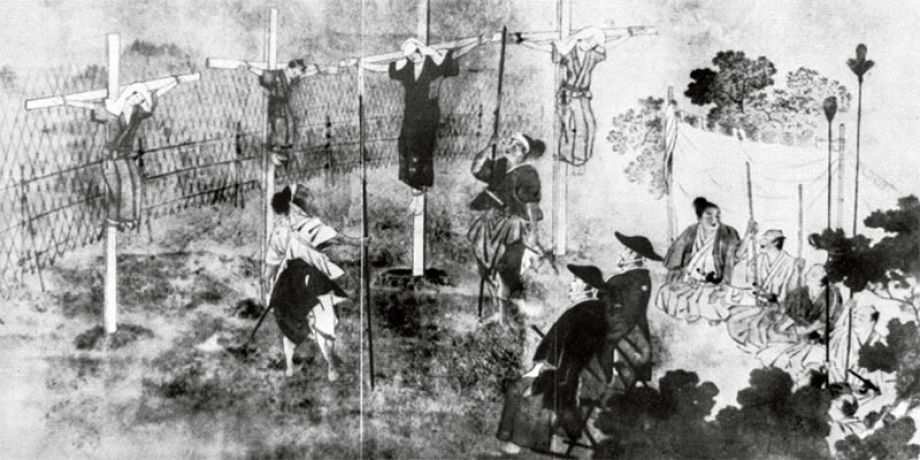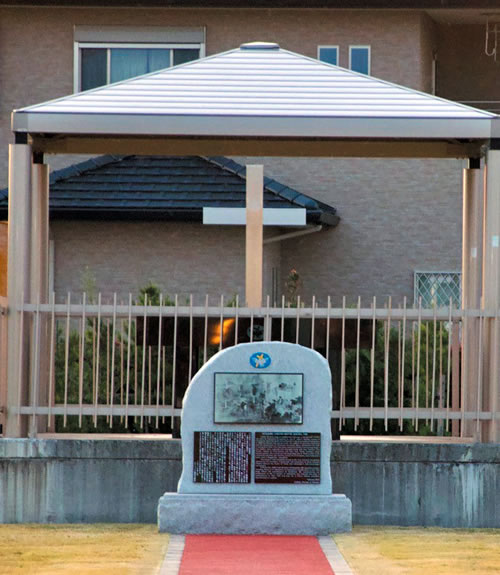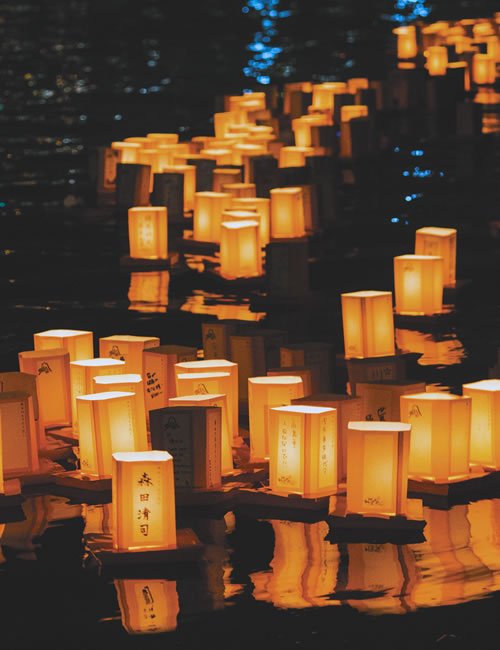
On Sept 8, 1993, in Beppu City on the Island of Kyushu, Our Lady prophesied through Fr. Stefano Gobbi that soon Japan will be a Christian country. She called it a miracle. That will be some miracle as at the moment there are only about 400,000 Japanese Catholics. Along with foreigners and the different Protestant denominations one can say that there are just over one million Christians in Japan today. That is a small group in a population of 125 million.
The great Jesuit missionary St. Francis Xavier landed in Kagoshima on August 15, 1550, the feast of the Assumption of Our Lady with three other Jesuits and a Japanese interpreter. He spent just two years travelling the country but had great difficulty with the language. Yet, in just 50 years I believe that Japan was well on its way to becoming a Christian Country.

At that time one of the great centers of activity was the area around Yatsushiro in the southern part of Kumamoto Prefecture on the island of Kyushu. This was due mainly to the fact that the Lord of the area, Augustine Konishi Yukinaga, was a Christian. There were a number of lords in Kyushu like Konishi who welcomed the priests and gave them every help and encouragement. In 1599 the population of Yatsushiro town was about 30,000. It is thought that many of them were Christians and at least fourteen churches had been built. Today there is just one church and about 150 Christians!
That year of 1599 witnessed an extraordinary miracle on April 25. A young Christian lad with a few of his pals were praying before a cross in a cemetery when the cross began to shine with a brilliant light. Great crowds visited the cross which continued to shine for three months as a result of which many more people were baptized. The miracle of the shining cross was surely a presage of the great storm that was approaching.
The battle of Sekigahara, October 21, 1600, was a decisive moment in Japanese history. There was a civil war largely fought between forces from eastern and western Japan. Konishi fought with the western forces but as a result of many betrayals the battle was lost. Being a losing general it would have been normal for him to have taken his own life but being a Christian, he would not do that. Subsequently he was captured and executed. His lands and castles were forfeited and given to Lord Kato Kiyomasa, an eastern general who began the serious persecution of the Christians.
Many of Konishi’s retainers fled to other clans. Some became retainers of Lord Kato. The priests and many Christians went south to Kagoshima. However, two of his Christian Samurai refused the order to reject their faith or leave Yatsushiro. Their names were John Minami and Simon Takeda. Lord Kato was furious and ordered that they both be beheaded and their families crucified.
At that time there was a very interesting apostolate active in every community known as the “Jihi Yaku” which means “ministry of mercy.” They were laymen who visited the families, teaching, praying, encouraging and preparing people for death. There were three such men in Yatsushiro: the mercy men were Michael Mitsuishi, John Hattori and Joachim Watanabe.
Because John Minami was so influential in Yatsushiro he was taken to Kumamoto for execution. He had said his farewells to his wife Magadlene and his adopted son Louis reminding them that they would all be united shortly in Heaven. Having reached Kumamoto he informed Lord Kato that one’s loyalty must always be first to the Lord of Lords (like St. John Fisher and St. Thomas Moore), and he was beheaded on December 8, the first martyr from Yatsushiro. He was 35.
“It is a glorious thing to die for the faith.”
— Johanna Takeda
Simon Takeda’s non-Christian friends suggested he just pretend to give up the faith. He refused. They tried to get his mother Johanna to reason with him, but she replied that “it is a glorious thing to die for the faith!” He bade farewell to his family and called on the services of the mercy men to prepare spiritually, asking them also to see to things after his death. He went to the garden, probably his own, where preparations had been made and became the second martyr from Kumamoto before dawn on December 9. He was 33. Johanna kneeling beside his body said “how blessed you are my son and how well you offered your life to our Lord! How blessed am I to be the mother of a martyr!” His head was sent to Kumamoto and joined John Minami’s, displayed as a spectacle and a warning on the main road into the town.
Their families were to be crucified the same day. They accepted their fate with great joy and prepared. Together they said the “confiteor” before a holy statue. When many people gathered to console them, the officials became alarmed and tried to hurry them up. However, the women, John’s wife Magdalene and Simon Takeda’s wife Agnes and mother Johanna informed them that as they were about to go before their Lord such preparations could not be rushed! Shortly afterwards they cheerfully called “let’s go!”
Because they were samurai families it was decided that they should be carried to the place of execution by palanquin. Agnes however requested that she be allowed to walk to her crucifixion like her Lord, but the request was denied. Johanna was the first to be tied roughly to her cross and from its lofty height proceeded to address the large crowd. “I assure you there is no salvation apart from the way of the Christians.” She called on people to seek baptism, on those who had left the faith to return and on those faithful to continue to be so. The executioner dispatched her with two stabs of his bamboo spear. She was 55. Next was Magdalene and her adopted son. Looking at his mother the lad repeated the names of Jesus and Mary as they had both being doing along their way of the cross. They died quickly. Louis was 8, and his mother was 33. Agnes was the last but at this stage the executioners were in tears, shaking, unable and unwilling to continue. Finally, a man came forward and took the spear. But he was so inept that he had to stab Agnes many times before she died. She was 30.

There were still many Christians in the town and the demands of the local officials to recant became more strident. As the missionaries were not allowed into the area it became the task of the mercy men to encourage the brethren and keep the flame burning. This they did to such good effect that there was a great sense of unity and the numbers began to grow again. In fact, even the man who had executed Simon Takeda became a Christian. The officials consulted with Lord Kato about the situation, and he ordered that the three mercy men be imprisoned until they die and their properties confiscated. On January 20, 1605, the three were imprisoned. They were put into a small stockade inside the first wall of the castle. They had no shelter from the elements and nothing but the ground to sit or lie on.
When the castle gates were opened in the morning anybody could enter and speak with the prisoners. As time went on the harsh treatment began to take its toll on the men, especially on Joachim Watanabe who was 55. When the word spread a Fr. Louis from Nagasaki, disguised as a farmer came and sat down on the low wall at the stockade to rest with his load of produce on his back and heard the confessions of the three. I’ve no doubt he often took a rest there over the following months.
Joachim died on August 26, 1606, from the harsh treatment and was buried. But three days later the Christians brought his body to Nagasaki and buried him beside John Minami.
At Christmas many Christians gathered at the stockade and with great joy, prayers, scripture readings and song celebrated the birth of Christ. It was like a small church. When Lord Kato got word of this he was incensed and ordered that they be executed along with their families. He was persuaded to let the wives live, but the two men joyfully prepared for death. Great crowds gathered. Officials hastened to their homes to bring their two children. Michael Mitsuishi’s son Thomas was playing when they came for him. He stopped his game, gave whatever he had to his pals, dressed himself in his best clothes and without shedding a tear bade farewell to his grandfather. He was slightly handicapped so the official carried him on his back. The three with heads bent in prayer were beheaded in turn with one flash of the sword. Thomas was 13, his father Michael was 50 and John Hattori was 39.
John’s son Peter had not yet arrived as his house was some distance away. Finally, an official carried him into that shocking scene; three bodies parted from their heads in a sea of blood. But the child stood there unflinching, loosened the upper part of his kimono, knelt down beside his father’s body and presented is neck to the executioner. The three executioners were in tears seeing the manliness of this child and refused to carry out the execution. However, a man from the crowd stepped forward and took the sword and dispatched Peter. He was 6.
The remains were gathered up and buried in the community grave but later were secretly brought to Nagasaki. Later all the Yatsushiro martyr’s remains were brought to Macao for safety when the missionaries were expelled in 1612. There they were placed in the Church of St. Francis Xavier. In Japan it is unusual to have martyrs’ relics as the officials took great pains to make sure there would be none.
In 1995 the relics of the Yatsushiro martyrs were returned to Nagasaki. On November 24, 2008, these eleven were among the 187 Japanese martyrs declared blessed in a great ceremony in Nagasaki which began with the relics being carried in procession to the altar. When I was appointed to Yatsushiro parish I wondered why those relics were not preserved here in Yatsushiro. The reason is that they were mixed with some other martyrs’ relics, and it’s not possible to distinguish one from the other. All one can say is that among this small collection of bones are the relics of some of the Yatsushiro martyrs. They are on display in the Jesuit Twenty-six Martyrs Museum on Nishizaka Hill where at least 650 Christians have been martyred.
To commemorate their beatification the Bishop of this Diocese bought a fine plot of land near the execution ground. It has been undeveloped up to the present with no prospect of that happening for the lack of funds. However, as the Columban Fathers celebrated the 100th anniversary of their founding and as Columbans had been working in this area for almost 70 of those years the Society generously agreed to fund that development. In 2018 that work was completed in time for the Martyrs’ Festival the following year when Bishop Miyahara, Fr. Leo Schumacher the Columban Superior of Japan, all the priests of the area with a large number of Christians turned up for a special Mass and blessing of what turned out to be a beautiful park, worthy of the martyrs’ memory.
I have heard it said that the blood of martyrs is the seed of faith. It is our hope that when the Yatsushiro`s martyrs’ blood really comes on stream its impact on the many people who visit the park might play a part in the miracle that will see Japan become a Christian country and a prophecy fulfilled!
Columban missionaries in Japan wrote this article.